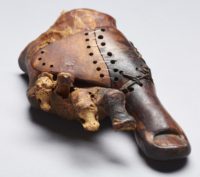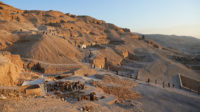 One of the oldest prostheses ever found has been reexamined by experts at the University of Basel in Switzerland using state of the art technology and it is an even finer piece of medical equipment than previously realized. One of the oldest prosthetic devices known (its precise age is unclear and there’s some overlap with the date range of the cartonnage Greville Chester toe), the Cairo toe is the oldest prosthetic discovered in situ, albeit disturbed from its original placement.
One of the oldest prostheses ever found has been reexamined by experts at the University of Basel in Switzerland using state of the art technology and it is an even finer piece of medical equipment than previously realized. One of the oldest prosthetic devices known (its precise age is unclear and there’s some overlap with the date range of the cartonnage Greville Chester toe), the Cairo toe is the oldest prosthetic discovered in situ, albeit disturbed from its original placement.
The wooden prosthetic toe was discovered in 2000 in a burial chamber in the necropolis of Sheikh ‘Abd el-Qurna near Luxor. It was one of multiple burials found in tomb TT95, one of five rock-cut tombs built into the eastward facing hillside of Sheikh ‘Abd el-Qurna. The tomb complex was built in the 15th century B.C. by order of Mery, High Priest of Amun under Amenhotep II (r. 1427–1401 B.C.), to hold the remains of his immediate family. Construction of the elaborate funerary chapel appears to have been interrupted by a cave-in, but the complex continued to be used for burials through the Late Period (4th century B.C.) and was adapted for use as housing in the Late Roman era. People lived in the complex off and on well into the 20th century.
 A shaft tomb in the entrance hall of TT95 was one of those later internments. It dates to the Third Intermediate Period (1069 B.C.- 664 B.C.) and had been extensive looted over the centuries. The mummified remains of a 50-to 60-year-old woman named Tabaketenmut, the daughter of a high priest who lived between 950 and 710 B.C., were found disarticulated in the fill of the shaft. The front half of the right foot was discovered intact with a wooden toe prosthesis connected to a well-healed amputation site with leather laces.
A shaft tomb in the entrance hall of TT95 was one of those later internments. It dates to the Third Intermediate Period (1069 B.C.- 664 B.C.) and had been extensive looted over the centuries. The mummified remains of a 50-to 60-year-old woman named Tabaketenmut, the daughter of a high priest who lived between 950 and 710 B.C., were found disarticulated in the fill of the shaft. The front half of the right foot was discovered intact with a wooden toe prosthesis connected to a well-healed amputation site with leather laces.
Egyptians made artificial parts for burial purposes, but this toe showed signs of having been of practical use during the woman’s lifetime. The prosthetic’s design was mechanically advanced and made for movement, not a cosmetic piece meant to adorn a dead body. It was made of three pieces of wood carved to precisely conform to the shape of the foot. The wood parts had holes drilled along the boundaries and leather string threaded through them and around the side of the foot, keeping the prosthetic securely attached while allowing articulated movement. It also has signs of wear that suggests its long-term use.
The toe is part of the collection of the Egyptian Museum in Cairo. Last fall, Egyptologists from the University of Basel started a new project to re-examine and thoroughly document all the remains and objects discovered in the TT95 tomb complex. The toe and the partial foot to which it was attached were part of this study.
The international team investigated the one-of-a-kind prosthesis using modern microscopy, X-ray technology, and computer tomography. They were able to show that the wooden toe was refitted several times to the foot of its owner, a priest’s daughter. The researchers also newly classified the used materials and identified the method with which the highly developed prosthesis was produced and utilized. Experts from the Egyptian Museum in Cairo – where the prosthetic device was brought to after it had been found – and the Institute of Evolutionary Medicine at the University of Zurich were also involved in this study.
The artificial toe from the early first millennium BC testifies to the skills of an artisan who was very familiar with the human physiognomy. The technical know-how can be seen particularly well in the mobility of the prosthetic extension and the robust structure of the belt strap. The fact that the prosthesis was made in such a laborious and meticulous manner indicates that the owner valued a natural look, aesthetics and wearing comfort and that she was able to count on highly qualified specialists to provide this.
Fascinating! In the third image, what is the object in front of the foot? Is it leather or textile?
Marilyn, likewise I have myself not really an idea. My guess here would be ‘cloth’, e.g. the remains of some sort of sandal, cap, sock or ring that she wore over her remaining toes and to which the wooden prosthetic toe was connected to, or maybe the other way round.
😎
Oh dear! – I feel a song coming on …
————
“Out there in the Desert their Sphinx, to my thirsty pleas Rocked deaf,
I tried even to Roll my Bangle, like a real Egyptian would have.
.. 🎶 …Meeh – ooh … Meh – ooh … 🎶
WAAA’K LIKE AN EGYPTIAAAAN !
WAAA’K LIKE AN EGYPTIAAAAN !”
————
Coincidence? I think not. :skull:
https://www.theguardian.com/world/2017/jun/20/canada-toe-stolen-drinks-dawson-city-downtown-hotel
“very familiar with the human physiognomy.” it’s a toe, for pharao’s sake.
Thank you for that *walk* down memory lane! As a weaver, I’m always fascinated by ancient textiles. I’d love get a closer look at this.
I seriously CANNOT be the only person still chortling over the phrase “well-healed” being present here (no actual heel included).
… Bueller … ?
No? Just me?
Hi
any chance you know the object/catalog number for this prosthetic toe? I know it is held in Cairo, The Egyptian Museum but i have not found any catalog info on their website. Any help would be really appreciated! 🙂